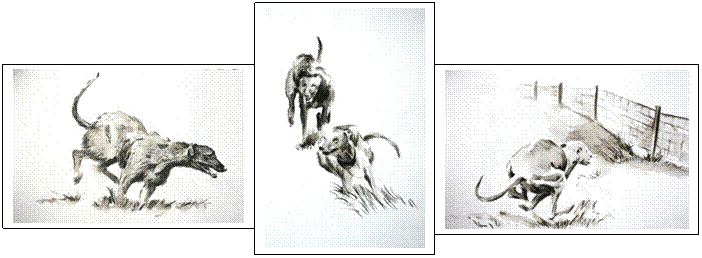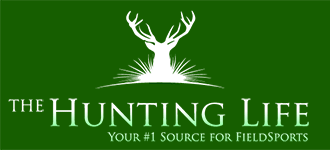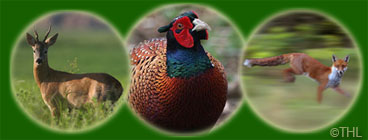Sketching Running Dogs

If some authors are to be believed then Ireland is ideally suited to producing running dogs, many top class greyhounds are bred here and apparently every other household is busy rearing a useful litter of pups. I’ve had little connection with greyhounds myself apart from frequenting a pub in my hometown named after its famous inhabitant; the celebrated Master McGrath who starred at the waterloo cup way back in the 1800’s. More recently I had a whippet lurcher, the fastest dog I’ve ever owned, who unfortunately collided with a car just prior to being entered and lived out her remaining days with three good legs and a limp. I’ve read all the books, studied the anatomy charts, become a regular at the kennels and dog tracks. I’ve also kept many other types of dog and stood in a lot of crap, (lucky I’m told), but even if I started to eat raw minced tripe and cock my leg at every lamp post, I’m not what many would regard as a doggie man. I couldn’t pick a winner, nor offer an insiders view, a tipsters guide or any guide. Images are my thing and dogs, running dogs in particular have become a rich and regular source of inspiration. Capturing their breathtaking action has long been a personal goal. A single afternoon at a race meeting provides important reference material for my paintings and a plethora of images of different types of dogs running; elusive images that are often extremely difficult to capture in the field or at the track. So I cant tell you which dog is likely to get a bump at the off, finish well over the distance or correctly mark a burrow entrance but I can tell you something of my efforts to capture the sense of speed and determination shown by the dogs as their contorted shapes emerge; muscles, teeth and dust.


My interest in sketching running dogs began when a greyhound trainer attending my weekly watercolour classes requested something to paint other than thatched cottages and hens. I agreed to go along to the local track to take a few reference snaps. This is a perilous occupation with numerous large bets at stake. If a camera flash was deemed to have affected the outcome of a race then the photographer would need to outrun the dogs or at least the punters to avoid a lynching. My initial request for official permission to photograph the action was therefore declined, so I opted for an unofficial approach and lurked at the side of the track. If the light was bad and I needed to use a flash, I held fire until the result was known but the dogs were still racing at full speed towards the kennel hands oblivious to the fact that they had already crossed the finish line and the race was over; their thirty seconds was up. My first greyhound painting was titled appropriately enough; ‘First bend’. It shows a group of dogs emerging from what is often the most important bend in a race. The final result is frequently decided at this point; an analogy with my artistic endeavours perhaps?

I placed the painting in a group exhibition along side two of my other paintings, one depicting a horse fair, and the other showing hens pecking in front of a thatched cottage. On the opening night I enjoyed some early success; the organiser informed me that I was the first artist to sell a painting. The one with the hens! Success with the dogs would have to wait. Undeterred I continued work on the dogs. A few months later I was doing a watercolour demonstration for a local art club, back on the hens theme for the night when a member of the audience remarked that he had seen my initial dog painting and asked if I could explain the portrayal of speed. Perhaps there was enough interest and who knows even a bit of money to be made from the dogs after all! I ‘clucked’ to myself, as once again the hens began to take shape on the canvas.
My whippet cross finally died last year but I haven’t come to today’s race meeting to find a replacement. I’ve come simply to enjoy the day, watch the dogs compete and fill a few pages of my sketchbook. Back at home I’ve still one old dog for company and until he gives up the ghost I wont be eyeing up the competitors. In the past I’ve had too many dogs at the one time with neither the time nor the expertise to do any of them justice, so I want to see how I get on by concentrating on just the one. Like I said before I’ve read all the books, talked to dog men, done my research but I know I’ve still got a lot to learn. Who doesn’t? When the old fella does go I’ll look for a pup with that subtle blend of sagacity and speed, qualities that might be found in a willowy first cross collie/greyhound or in a whole host of lurcher variations bred for a specific task or simply to augment their masters wandering habits. The sort of dog not destined to win many races. Until then I can satisfy my hunting instincts with my fishing rods and gun. In the meantime I’ll continue to wander the hills and work on the sketches.
I often find the images thrown up by an evening or early morning walk as appealing as the sight of the traps springing open. Walking dogs has always been one of my favourite occupations – part of the attraction of art is the fact that I could walk dogs as part of a job, taking colour notes, completing sketches and collecting source material. An unwalked dog peering out from the kennel is a sorry sight that drums up guilty feelings, in the dogs mind what is more important than getting out to sniff about – like many things in life if you are too busy to walk your dog then you are simply too busy. I’m often too busy, but when out on the hills I quickly come round to the dogs way of thinking.

Back at the lurcher and terrier show its already mid afternoon before the 11 o’clock race meeting finally gets underway. The sun beats down and the tension mounts as the race entries are laboriously recorded and the running order agreed. The pups go first. This gives the lads operating the lure a chance to fine-tune the equipment and gives the handlers with impatient dogs waiting to race, a chance to test their grip. The quality of dog leads and collars are also fully tested and quite a few found wanting as every single dog tries to get in on the action of the opening races. Its wonderful to see the pups finally released and in a split second realise what life is all about. Breeding and ancient race memories kick in as they get a taste of their future role in life. The thrill of the chase. The hunting life.


Snapped collars and slack grips quickly reverse roles, as the novice hunters suddenly become the hunted when an assortment of full-grown lurchers, longdogs and terriers break free from the crowd of spectators. A huge deerhound cross upends a spectator in a rush to join the fun. Ignoring the lure, it sets its sights on a trailing whippet. The whippet turns on a sixpence; wrong foots the deerhound and disappears through a gap in the fence leaving the rest of field in disarray.

Wayward hounds are quickly recovered by embarrassed owners and restrained with sturdy belts, braces and binder twine. It will take a few more starts before the succession of unwanted competitors is finally eliminated from the races. But wagers aside, who really cares? It’s a great day out for both the handlers and the dogs; as long as it is not taken too seriously. The real test of lurcher’s worth takes place far away from the cheering crowds, no cups are presented and speed alone does not guarantee success. Once brains and fieldcraft are added to the mix we have the makings of a dog that has a chance of becoming a top class worker. A dog that will need time and attention if it is to succeed on a windswept hillside. A dog that will hopefully earn its keep and become a useful companion in the field. A man will need a lot more than a strong grip or even a paintbrush to do it justice.

Anon


